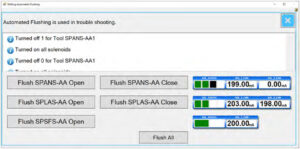Software applies real-time data, automation to redefine wireline sleeve shifting operations
Using available instrumentation, workflows can be streamlined to reduce reliance on individual experience, improve overall reliability

By Stephen Whitfield, Associate Editor
The success of conventional wireline intervention shifting typically depends heavily on the field engineer’s experience and knowledge. Any error in that individual’s judgment could lead to nonproductive time (NPT), or even total failure.
To help redefine the selective shifting workflow, Schlumberger has developed new surface acquisition software. It leverages available instruments and uses an automated real-time data collection system to streamline and simplify procedures, eliminating or reducing human error and reducing the burden placed on the field engineer for post-job deliverables.
“When you’re operating the shifter, you have to rely a lot on the engineer’s judgment. It’s pretty time consuming because we have to do a lot of operations for this, and if you somehow get things wrong or take a wrong step, you have to go back. That can take a lot of time,” said Jisheng Li, Software Engineer at Schlumberger, during a presentation at the 2022 SPE/ICoTA Well Intervention Conference in The Woodlands, Texas, on 22 March.
In a conventional shifting operation, he said, it is possible to miss the collar joint, waste considerable time finding the location, or even perform the shifting operation at the wrong location. The software correlates the completion mapping depth based on the operator-provided completion table, creating a channel similar to a casing collar locator (CCL) recording, thus enabling side-by-side correlation directly on the depth log. The software also renders details of the well completion mapping and shifting tool string on the same graph for visualization of the relative locations of the toolstring, the shifting target and the collar joints in real time.
The software allows users to initiate an automated seeking function to locate and latch the shifter key onto the target profile within a few millimeters in the well, including extended-reach drilling and wells intervened on a floating installation. Critical data from each user operation is logged and displayed on a two-dimensional plot and customized table, and users can generate operations reports that include all relevant data.
The software addresses five key challenges in sleeve shifting operations: precise depth control for toolstring conveyance, target profile seeking and latching, winch seeking, operations reporting, and troubleshooting and reliability improvements.
To address depth control, Schlumberger developed a two-step correlation process based on completion mapping that it embedded into the software as part of the shifting operation workflow. In the first step, the software imports a completion mapping profile into the software system and creates data channels and logs that can help real-time correlation on an acquisition log. Then, it implements the depth control user interface that integrates both completion mapping and toolstring details with real-time movement for visual correlation and depth control.
Mr Li said this process allows users to monitor, in real time, both the toolstring position and speed in the well. It also simplifies the operation of conveying the tool to the desired target depth, eliminating the risk of missing completion joints.
For the target profile seeking and latching challenge, Schlumberger embedded tool control automation into the software. This enables automatic seeking, latching and shifting of the target. The user inputs operational parameters, and the software then controls the downhole tool operation.
In the winch seeking operation, the software has what Schlumberger calls a “profilometer mode,” where it estimates the shifter’s open diameter. In this mode, the shifter force will change accordingly with the inner diameter (ID) of the sections. The well ID can be estimated from the shifter pressure, and when the toolstring is pulled by the winch to seek the target, the open diameter is computed from the force measurement. By comparing the shifter open diameter to the known profile IDs of different sections, users can tell where the shifter is located inside the profile and if it is in the correct latch location.
To improve troubleshooting and reliability issues, Schlumberger focused on the most common cause of downhole shifting toolstring malfunctions – clogged solenoids, which often result in the inability to control hydraulic pressure in the system and the tool modules not operating properly. The software automates the process of unclogging the solenoids by turning them on and off while the motor is running, building up enough pressure in the tool to flush debris away from the solenoids and resume normal tool functionality.
To address client reporting challenges, an automated real-time reporting tool was incorporated into the software. A data interpretation module correlates the tool’s operational status with relevant data channels from the downhole tools, interpreting and recording key operational events with real-time measurements. The software tabulates the events and related information in chronological order during the job. This logging table is available to users in real time and after the job.
“We wanted this software to provide real-time integration of all the events that go on during a shifting operation, where it can automatically put all of these events in a log, so the engineer can take a look at it and see if something’s going wrong. If there is something wrong, you can look through this log and immediately work on troubleshooting,” Mr Li said.

Case study
At the conference, Mr Li presented the results from a system integration test (SIT) Schlumberger performed on the software. The test setup consisted of a 333 ft-long completion, including the following sections: 7-in. tubing, 4.5-in. tubing, 3.5-in. tubing, 5-ft sliding sleeve and then an additional 6 ft of 3.5-in. tubing.
The wireline toolstring used in the test consisted of a four-section tractor, followed by the shifting tool module. The completion mapping information was loaded into the software.
The depth control panel was used to display the shifting toolstring inside the completion. The position of the toolstring was defined per the winch depth measurement and an offset correction. The depth of the end of the 6-ft section of 3.5-in. tubing was set at an artificial depth of 10,302 ft.
The objectives of the SIT were to use the depth control panel to deliver the tool 7 ft above the sliding sleeve lower profile, and then start the automated seeking/shifting sequence to latch and shift the sliding sleeve down to open. The SIT was started with the toolstring inserted at the uphole end of the tubing. The tractor was used to tractor down. As the CCL module passed through the 7-in. tubing to the 4.5-in. tubing, the CCL signal was recorded. The tractor controls were set so the tractor stalled as the bottom-most drive hit the restriction. The first drive was closed while the other three drives were kept open. This allowed the toolstring to move forward until the second drive hit the restriction.
The tractor navigation sequence was continued by opening the first drive, closing the second drive and tractoring down again. This allowed the tool to move down until the third drive hit the restriction. The second drive was opened and the third drive was closed, allowing the tool to move down until the fourth drive hit the restriction.
At this point, the shifting tool was opened in seek mode, incorporating a suspension system that allowed it to compress to pass through restrictions or expand into openings. The third tractor drive opened, and the fourth drive was closed. The tractor was started, and the tool moved down until the tractor stalled. The higher tractoring force was selected, causing the shifting tool to be compressed and pass through the 4.5-in. to the 3.5-in. restriction. In seek mode, a profilometer option can be used to isolate the hydraulic chamber in the shifting tool. Fluctuation of the pressure then gives an indication of the change in diameter.
The shifting tool diameter change measurement can then be used to measure change in diameter up to 1 in. In this case, the shifting was compressed from 3.9-in. diameter to 2.99-in. diameter, another indicator that Mr Li said helped to locate the toolstring in the completion. The shifting tool was opened near the end of and inside the 4.5-in. tubular, after which it was compressed to pass through the restriction and enter the 3.5-in. tubular.
After the shifting tool passed the restriction, the next indication came from the CCL module passing through the 4.5-in. to 3.5-in. tubing restriction. The tractor then stalled when the bottom-most drive hit the 4.5-in. to 3.5-in. restriction. The tractor navigation was executed, and the fourth and last drive hit the restriction. This was the last indication before the shifting tool entered the sliding sleeve.
The depth control panel, the CCL signal, tractor motor stall indicator and shifting tool ID measurement were used to deliver the shifting tool 5 ft above the sliding sleeve. The shifting tool pressure was then increased to use it as an anchor and prevent the toolstring from sliding inside the tubing. The tractor drivers were closed. Afterwards, the operation was completed using the automated seeking/shifting sequence, which consisted of activating the tool using pre-selected parameters so that it moved in an inchworm-like motion toward the profile and latches, shifting the sleeve. In this case, the downhole direction was selected. The shifting tool latched and shifted the sleeve without stopping.
Ultimately, Schlumberger hopes to enable “one-click” operation with the software, Mr Li said, although he noted this would require the software to be fully automated over the wireline. To accomplish this full automation, automated winch operation must be incorporated into the workflow, and a decision-making method that better incorporates artificial intelligence will likely be needed to identify different phases of the operation.
Further improvement on linear actuator displacement measurement would also allow micro-level correlation with submillimeter-grade accuracy. Mr Li said this could potentially be achieved by fusing multiple measurements, including the accelerometer measurement, the tractor speed, the pumping motor speed of the shifting tool, and the winch depth measurement. DC
For more information, please see SPE 208992, “Advanced Software Features to Enable Smart Downhole Valve and Sleeve Shifting Operation.”




